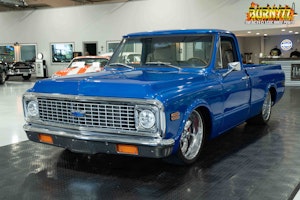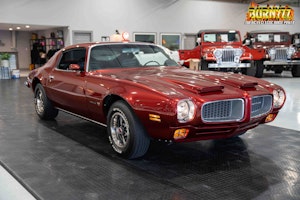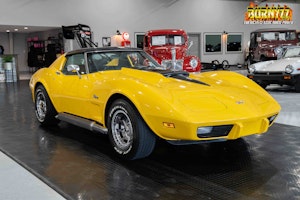Media | Articles
Luftgekühlt: An automotive music festival where Porsches sing
“Quick” Vic Elford, retired legendary Porsche works driver and F1 racer, stepped into a 1968 Porsche 908K racing car and cranked over its 3.0-liter flat-eight engine. With a rasping, ear-battering blast of sound, the air-cooled eight snapped and snarled to life. A huge cloud filled the air, choking bystanders before wafting up to the high rafters. Then he turned off the car and everybody cheered. Welcome to Luftgekühlt.
Formerly an intimate gathering for those in the inner circle of air-cooled Porsche enthusiasm, Luftgekühlt has quickly spooled up in size and popularity as if fitted with a turbocharger. Now in its fifth year, it sold out completely, both for entrants and spectators, filling an entire lumber yard with all shapes and sizes of air-cooled Porsches and the people who love them.
Elford climbed from the 908K to be greeted by Patrick Long and Jeff Zwart, both longtime Porsche racers and enthusiasts. The men grinned and slapped each other’s backs, their love of loud-ass racing machines clearly unblunted by years of exposure to them. This is the very same 908K that Elford campaigned in Belgium at the Spa 1000km race some 50 years ago.
20180423190445)
20180423192011)
Long, who drove a 911 to class victory at the 24 Hours of Le Mans twice, is one of Luftgekühlt’s two original founders. The other is Howie Idelson, a designer who just happens to be a champion kart racer. It was at the kart track that the two friends originally met. Later, while collaborating on the design of an Oakley driving shoe, they came up with the idea of a small Porsche-themed show that would be an antidote to stuffy concours events.
Marketplace
Buy and sell classics with confidence
Despite the presence of a $3 million race car, Luftgekühlt ain’t Pebble Beach. Spectator tickets to Luftgekühlt cost just $35, everybody is in t-shirts, and there are kids everywhere. The whole event has the air of a music festival. It’s just that the music in question is fueled by internal combustion.
The location, a spotless lumber yard in Torrance, California, is a far cry from the usual parking lot or golf course fairway that normally functions as the backdrop for a car show. It’s a perfect fit for a Porsche event, as the company can trace its earliest days to the grounds of a former sawmill in Gmünd, Austria. The owners of this yard, Ganahl Lumber, also trace their family roots back to Austria.
Perhaps that’s why the early 1949 Gmünd-built 356/2 coupe owned by Jerry Seinfeld looks so perfect framed against a rough wooden wall. You can see the work of human hands in the coupe’s painstakingly-shaped bodywork, its surface almost leather-like in texture. This is the book of Genesis in the Porsche Bible.
20180423191158)
Revelations can be found just footsteps away. Inside the cavernous warehouse, Bruce Canepa showed off his 959SC, a reimagining of perhaps the most advanced air-cooled Porsche ever. Originally a 450-hp, all-wheel-drive monster intended to race in Group B, the 959 became the poster car for an entire generation of gearheads. Canepa’s version lets the 959 regain its supercar supremacy.
“We’re always pushing,” he says with a laugh, opening the hood to show the 959SC’s gleaming, twin-turbocharged heart. Restored to concours quality with an every-bolt thoroughness, the 959SC it tuned up to 800 hp, enough to leave a modern Lamborghini in its wake. Despite the eye-watering cost—more than $2.5 million—three are already pre-sold, including this gorgeous blue-on-red vision.
Close by is perhaps the only road car that could give the 959 pause, and technically the only water-cooled Porsche here. The last of the five Vern Schuppan 962CRs, it was originally intended to race at Le Mans. It has a mid-mounted flat-six engine that makes 800 hp on high boost, and is capable of a claimed 230 mph.
“I have a plate for it, but I can’t drive it! It’s pure torture,” jokes the car’s owner, the surprisingly young Matthew Ivanhoe. With only a single mile on the odometer, this Porsche is more rolling sculpture than Le Mans for the street.
20180423191951)
20180423190256)
20180423190407)
20180423191703)
The 962CR drew a crowd, and Ivanhoe was soon chatting with Chad McQueen, because that sort of thing happens at Luftgekühlt. But lest you think the show is all VIPs and seven-figure machinery, more common cars are just a few rows away.
In between the stacks of timber were all manner of Porsche 911s, 914s, 912s, and 356s. As I passed a lovely, Guards Red 964-chassis 911, I heard a thick New Jersey accent boom. “I raised a son to take care of my Porsche.” Joe Lombardi has his son—also named Joe—hard at work polishing the last few details on his 1985 911. Both Lombardi Sr. and Lombardi Jr. are recent transplants to California, about which Senior has a few opinions.
“The pizza sucks, and the bagels suck,” he says, “but I can live with it for the weather.”
California car-culture lends itself well to impromptu gatherings and cruises, and anyone who owns an air-cooled Porsche around here has ample opportunity to get it out on the road. Lombardi Jr. shows me pictures of his widebody 914 2.0L, built as an homage to a 914-6. Air-cooled Porsche enthusiasm is multi-generational.
20180423191645)
It also doesn’t seem to obey any rules. For every well-restored 911 gleaming in the sun, there’s one with a full patina and another modified example. Derek Whitacre’s 1982 Porsche 911SC is just as monstrous as Canepa’s vision or Ivanhoe’s rare beast, but it’s also a little rough around the edges—purposefully so.
“It’s hot-rodding,” Whitacre says. “I never thought of a Porsche as being a hot rod, but that’s what it is.”
With a built 3.4-liter turbocharged flat-six putting 420 hp to the wheels in a car that weighs just 2600 pounds, Whitacre’s machine is emblematic of Southern California-style Porsche speed. He and some Porsche-owning friends recently returned from a long-distance road-rally in Mexico.
The 911SC is a collection of parts that might drive a Porsche purist nuts: 993 front brakes, a huge intercooler that pokes out of the rear wing, a roll-cage built in Singer’s shop before that company took off. However, Whitacre says he doesn’t usually get any pushback from the local Porsche enthusiasts. Even if it breaks the rules, people love his car.
20180423191802)
20180423191223)
20180423190342)
And really, that’s the truth at the heart of what makes Luftgekühlt so special. The cars are arranged in rows, roughly divided by model year or restoration level. There are squadrons of racing machines and packs of turbocharged outlaw 911s. The really fancy and expensive stuff is placed on pedestals made out of pallets of wood.
But while cars and people are grouped together naturally, there aren’t any dividing lines here. Snatches of overheard conversation show that everybody is excited about pretty much everything they’re seeing, whether it’s a wrinkly-looking 356 coupe, or a flawless yellow Ruf BTR.
Five years on from its inception, Luftgekühlt has nailed what makes car culture truly great. It isn’t about the shine or the speed, nor the dollar value of what you’ve got. It’s about the shared love of the machinery, a respect for heritage, and a sense of belonging. You don’t even have to own a Porsche to fit in here. You just have to be the sort of person who cheers when an old racing car bursts to life again, its air-cooled engine crackling and bellowing, the sound at once music and thunder.
20180423191850)








20180423190233)
20180423190742)
20180423191906)
20180423191916)
20180423190330)
20180423190521)
20180423190545)
20180423190612)
20180423190633)
20180423190714)
20180423190804)
20180423190846)
20180423190900)
20180423190915)
20180423190954)
20180423191013)
20180423191031)
20180423191051)
20180423191118)
20180423191144)
20180423191241)
20180423191300)
20180423191318)
20180423191409)
20180423191431)
20180423191454)
20180423191522)
20180423191546)
20180423191608)
20180423191724)
20180423191834)

